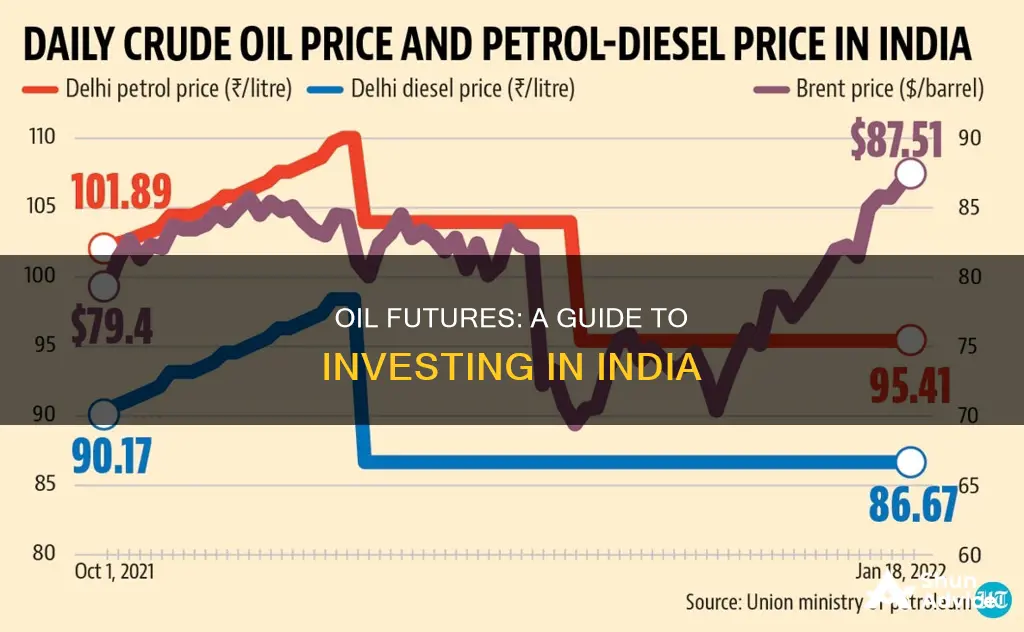
Oil is a vital natural resource for the world economy, and investing in it can be a lucrative opportunity. Oil futures are contracts in which buyers and sellers of oil agree to deliver a particular amount of physical crude oil on a given date in the future at a predetermined rate. They are a way for investors to profit from fluctuations in the barrel price.
There are two major oil contracts that are watched by the oil market participants. North America's benchmark for oil futures is West Texas Intermediate crude, which trades on the New York Mercantile Exchange. In Europe, Africa, and the Middle East, the benchmark is the North Sea Brent Crude that trades on the Intercontinental Exchange.
Investing in oil futures can be done directly through a commodities exchange or a registered broker, or indirectly through oil-related ETFs. However, it is important to note that investing in oil futures carries risks, including the volatile nature of oil prices.
| Characteristics | Values |
|---|---|
| Oil futures contract | An agreement to buy and sell a particular amount of barrels of oil at a predetermined rate on a pre-decided date |
| Who is it for? | End-users of oil purchase on the futures market to lock a price; investors buy the futures as a gamble on what the price would be in the future |
| Margin payment | A margin payment that covers a % of the total value of the contract is required |
| Major oil contracts | West Texas Intermediate crude (North America), North Sea Brent Crude (Europe, Africa, Middle East) |
| Frequency of oil futures | Futures for oil settle monthly. Other futures contracts settle only four times a year |
| Oil prices | Fluctuate a lot |
| Oil demand | Oil is still one of the most in-demand commodities in the world |
| Cash holding needs | 5% |
| Oil prices over time | The idea that the prices would have to go up with time |
| Ways to buy crude oil futures | Buying oil futures directly, buying and selling ETFs |
What You'll Learn

Oil ETFs
There are several oil ETFs available in India, such as the WisdomTree WTI Crude Oil ETF (CRUD), which tracks the performance of West Texas Intermediate crude oil futures. Another option is the Invesco DB Oil Fund (DBO), which invests in crude oil futures and seeks to minimise negative roll yields.
It is important to note that oil ETFs are subject to tracking errors and may not always deliver the return of the underlying index or crude oil prices. Additionally, they are suitable only for short-term speculation due to the frequent negative roll yield as futures contracts expire.
Before investing in oil ETFs, it is crucial to understand the risks and volatility associated with the oil markets. Oil prices are influenced by various factors, including supply and demand, geopolitical events, and the performance of oil-producing companies.
Waste Management: A Smart Investment for a Sustainable Future
You may want to see also

Oil stocks
When investing in oil stocks, it is important to research a company thoroughly before buying its stock. It is generally advisable to have the majority of a portfolio invested in mutual or index funds rather than individual stocks, due to the diversification that funds provide.
- Oil India Ltd
- Oil & Natural Gas Corporation
- Indian Oil Corporation
- Reliance Industries
- Bharat Petroleum Corporation
- Hindustan Petroleum Corporation
Oil funds, such as exchange-traded funds (ETFs) and index funds, can also be a good way to gain exposure to the oil industry. ETFs are traded on an exchange, and investors can buy individual shares of an ETF similar to stocks. Oil ETFs tend to be inexpensive, often trading for $30 or less. Here are some examples of oil ETFs:
- SPDR Energy Select Sector Fund (XLE)
- SPDR S&P Oil & Gas Exploration and Production ETF (XOP)
- VanEck Vectors Oil Services ETF (OIH)
- IShares U.S. Energy ETF (IYE)
- Vanguard Energy ETF (VDE)
Investment Options for College Savings: What Are Your Choices?
You may want to see also

Oil futures
In India, there are two main oil futures contracts that are closely watched by market participants:
- West Texas Intermediate (WTI) crude oil, which is the benchmark for the North American market and trades on the New York Mercantile Exchange (NYMEX).
- Brent crude oil, which is the benchmark for Europe, Africa, and the Middle East and trades on the Intercontinental Exchange (ICE).
When considering investing in oil futures, it is important to recognise the difference between these two types of crude oil. WTI is primarily produced in the US Permian Basin and has lower sulfur content, while Brent crude comes from fields in the North Atlantic and has a higher sulfur content. Additionally, WTI is more influenced by local US factors, whereas Brent crude is a better indicator of worldwide pricing due to its heavier trading volume in global futures markets.
To invest in oil futures in India, you would typically need to work with a broker that offers futures trading and has access to the relevant exchanges, such as NYMEX or ICE. It is worth noting that investing in oil futures can be complex and risky, so it is generally recommended for experienced traders.
How Interest Rates Affect Savings and Investments
You may want to see also

Oil options
In India, oil options are traded on commodity exchanges such as the Multi Commodity Exchange (MCX). An Indian crude oil option chain has numerous strike prices and different expiration dates, giving traders multiple options for speculation.
Advantages of Trading in Oil Options
- Leverage: Options allow investors to take positions on large amounts of crude oil with relatively small investments. This is particularly useful given the volatility of the crude oil market, where small price movements can result in large profits.
- Flexibility: Oil put and call options enable traders to take a view on rising and falling markets, accommodating a wide range of trading strategies.
- Risk Management: Oil options track adverse price movements in the physical market. For example, a business firm can buy options to protect against rising crude oil prices.
Ways to Trade Oil Options
- Trade Oil Options with CFDs (Contracts for Difference): CFDs are not widely traded in India, but they offer great flexibility. A trader using CFDs can take long and short positions and profit from both rising and falling prices.
- Trade Oil Options with a Broker: In India, oil options are usually traded through a registered broker. Brokers grant access to the oil options chain, with multiple strike prices and expiry dates. They help traders enter trades, manage positions, and gain market insight.
How to Trade Oil Options
- Understand How Oil Options Work: Before trading, it's essential to understand how oil options chains display available contracts, categorised by strike price and expiry date. Traders choose between call options (right to buy) and put options (right to sell).
- Learn What Moves Option Prices: The price of oil options is influenced by the underlying crude oil price, volatility, time to expiry, and interest rates. Monitoring the oil option chart provides insights into price trends.
- Choose to Trade Using CFDs: CFDs allow trading oil options without owning the physical asset. While less common in India, they can be effective for experienced traders capitalising on short-term price fluctuations.
- Create a Trading Account: You must create an account with a registered broker who provides access to the oil price option chain in India and offers a user-friendly platform.
- Determine Your Preferred Expiry: The expiration date plays a critical role in determining an option's value. Short-term traders may prefer near-term expiries, while long-term investors might opt for distant ones.
- Decide Whether to Buy or Sell Calls or Puts: If you expect the price of crude oil to rise, buying a call option or selling a put option might be the right strategy. Conversely, buying a put option or selling a call option could be more appropriate if you anticipate a price drop.
- Open and Monitor Your Position: Monitoring your position closely is essential. The oil option chart helps track price movements and assess trade performance. Adjust your strategy to maximise profits or minimise losses.
Savings and Investments: Your Guide to Financial Freedom
You may want to see also

Oil mutual funds
- Vanguard Energy Fund Investor Shares (VGENX): This fund was established in 1984 and seeks to provide long-term capital appreciation by investing at least 80% of its assets in companies primarily engaged in activities related to the energy industry. As of June 30, 2021, VGENX manages $4.8 billion in investor assets. The fund has a relatively low expense ratio of 0.37%, and investors do not pay any sales load for investment. However, a minimum initial investment of $3,000 is required.
- Fidelity Select Energy Portfolio (FSENX): Managed by Fidelity Investments, FSENX has been available to investors since 1981. It invests a minimum of 80% of its assets in securities of companies engaged in energy field activities, including oil, gas, electricity, coal, and new energy sources. FSENX has generated a 10-year annualized return of -2.08% as of June 30, 2021, and has an expense ratio of 0.85%. Shares are available without any sales charges, and there is no minimum investment requirement. Top holdings include Chevron, Exxon Mobil, and ConocoPhillips.
- BlackRock Natural Resources Trust Fund (MDGRX): This fund, established in 1994, seeks to provide long-term capital growth by investing the majority of its assets in securities of companies with substantial natural resource assets, including energy, chemicals, oil, gas, and mining. As of June 30, 2021, MDGRX has generated a 10-year annualized return of 0.82%, with an expense ratio of 1.26%. A minimum investment of $1,000 is required, and investors must pay an upfront sales load of 5.25% for new share purchases. Top holdings include Chevron Corp and TotalEnergies.
- Integrity Mid-North American Resources Fund (ICPAX): Offered through the Integrity family of mutual funds, ICPAX seeks to provide long-term capital appreciation by investing primarily in the stock of domestic and foreign companies participating or benefiting from the development of resources in the Williston Basin area. The fund may also invest in equity securities of companies in the development stage or those without significant revenues. ICPAX has generated a 10-year annualized return of -2.23% as of July 2021, with an expense ratio of 1.50%. A minimum investment of $1,000 is required, and investors pay a 5% upfront sales charge on all new investments. Top holdings include Cabot Oil and Gas, and Phillips 66.
- Thematic-Energy Mutual Funds: These funds are equity mutual funds that invest in stocks tied to the energy sector. While they carry high risk due to their dependence on the performance of the energy theme, they offer broad-based diversification. Examples include the DSP Natural Resources and New Energy Fund, Tata Resources & Energy Fund, and ICICI Prudential Energy Opportunities Fund.
It is important to note that investing in oil mutual funds carries risks due to the volatile nature of energy prices. Before investing, it is essential to carefully consider your investment objectives, conduct thorough research, and, if necessary, seek advice from a qualified financial advisor.
Brexit-Proof Your Investment Portfolio: Strategies for Volatile Markets
You may want to see also
Frequently asked questions
Oil futures are contracts in which buyers and sellers of oil agree to deliver a particular amount of physical crude oil on a given date in the future. The price of the oil is predetermined in the contract.
You can buy and sell oil futures directly with a commodities exchange or through a registered broker. You will need a specialised account with a brokerage that offers futures trading.
Oil prices are volatile, which adds to the level of difficulty when trading but also increases the potential profitability. Oil is still in high demand globally, so there will always be a buyer. You can also utilise margin accounts to trade oil futures, which can increase potential profitability.
Oil is a vital resource for the global economy, so its price is sensitive to changes in the pace of global economic growth. Demand for oil can fluctuate, and economic slowdowns or recessions can lead to a decline in oil prices. Geopolitical issues can also affect the supply and demand of oil, impacting prices.







